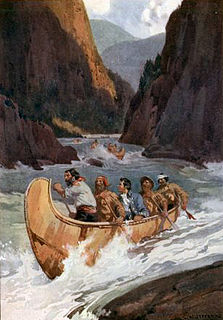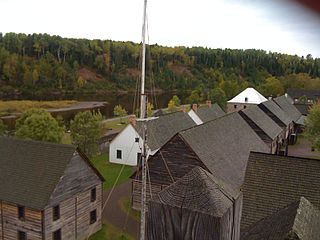Fort Edmonton was the name of a series of trading posts of the Hudson's Bay Company from 1795 to 1891, all of which were located in central Alberta, Canada. From 1795 to 1821 it was paired with the North West Company's Fort Augustus. It was the end point of the Carlton Trail, the main overland route for Metis freighters between the Red River Colony and the west and an important stop on the York Factory Express route between London, via Hudson Bay, and Fort Vancouver in the Columbia District.
John Rowand was a fur trader for the North West Company and later, the Hudson's Bay Company. At the peak of his career, he was Chief Factor at Fort Edmonton, and in charge of the HBC's vast Saskatchewan District.

Rocky Mountain House is a town in west-central Alberta, Canada located approximately 77 km (48 mi) west of the City of Red Deer at the confluence of the Clearwater and North Saskatchewan Rivers, and at the crossroads of Highway 22 and Highway 11. The surrounding Clearwater County's administration office is located in Rocky Mountain House.

Cumberland House is a community in Census Division No. 18 in northeast Saskatchewan, Canada on the Saskatchewan River. It is the oldest settler community in Saskatchewan and has a population of about 2,000 people. Cumberland House Provincial Park, which provides tours of an 1890s powder house built by the Hudson's Bay Company, is located nearby.
Fort Espérance was a North West Company trading post near Rocanville, Saskatchewan from 1787 until 1819. It was moved three times and was called Fort John from 1814 to 1816. There was a competing XY Company post from 1801 to 1805 and a Hudson's Bay post nearby from 1813 to 1816. It was on the Qu'Appelle River about 20 km from that river's junction with the Assiniboine River and about 7 km west of the Manitoba border. It was on the prairie in buffalo country and was mainly used as a source of pemmican which was sent down the river to Fort Bas de la Rivière at the mouth of the Winnipeg River.

Fort Carlton was a Hudson's Bay Company fur trade post from 1795 until 1885. It was rebuilt by the Saskatchewan government as a provincial historic park and can be visited today. It is about 65 kilometers north of Saskatoon.

The York Factory Express, usually called "the Express" and also the Columbia Express and the Communication, was a 19th-century fur brigade operated by the Hudson's Bay Company (HBC). Roughly 4,200 kilometres (2,600 mi) in length, it was the main overland connection between HBC headquarters at York Factory and the principal station of Columbia Department, Fort Vancouver.
Buckingham House (HBC) and Fort George (NWC) were two trading posts on the North Saskatchewan River near Elk Point, Alberta, from 1792 to 1800. Buckingham House belonged to the Hudson's Bay Company and Fort George to the North West Company. For background see Saskatchewan River fur trade.

Green Lake is a northern village in Saskatchewan, Canada. Its residents are predominantly Métis people. Green Lake is located northeast of Meadow Lake, and northwest of Big River. It lies in the southern boreal forest, and takes its name from nearby Green Lake. Fishing, tourism, and farming, are the major industries.
Fort de l'Isle is a site in Alberta, Canada, containing the remains of three trading posts that existed from 1799 to some time before 1808. The island the North Saskatchewan River on which the posts were located is about 47 miles west of the Saskatchewan border and about 7 miles north of Myrnam. The west end of the island can be seen from the Alberta Highway 881 bridge.

Revillon Frères was a French fur and luxury goods company, founded in Paris in 1723. Then called la Maison Givelet, it was purchased by Louis-Victor Revillon in 1839 and soon, as Revillon Frères, became the largest fur company in France. Branches were opened in London in 1869 and in New York in 1878. At the end of the 19th century, Revillon had stores in Paris, London, New York City, and Montreal.
South Branch House was the only significant fur trading post on the South Saskatchewan River. Most trade was on the North Saskatchewan River which was closer to the wooded beaver country. West of the Saskatchewan River Forks the two rivers run parallel to the northeast for about 100 miles. Between them there is a fair amount of forest.
Fort Sturgeon (1776–1780) was the first trading post on the North Saskatchewan River. It was located about 4 miles west of Prince Albert, Saskatchewan. It and was also called Peter Pond Fort, Fort Pond, Fort la Prairie, Fort des Prairies, Lower Settlement and Fort Sturgeon River.
Pine Island Fort and Manchester House were trading posts on Pine Island, a small narrow island on the North Saskatchewan River in Saskatchewan, Canada, from 1786 to 1793. Pine Island Fort was a post of the North West Company while Manchester House was a post of the Hudson's Bay Company.

Saskatchewan River fur trade The Saskatchewan River was one of the two main axes of Canadian expansion west of Lake Winnipeg. The other and more important one was northwest to the Athabasca Country. For background see Canadian canoe routes (early). The main trade route followed the North Saskatchewan River and Saskatchewan River, which were just south of the forested beaver country. The South Saskatchewan River was a prairie river with few furs.
Brandon House was a Hudson's Bay Company post or posts from 1793 to 1824. It was located at several places on the Assiniboine River between Brandon, Manitoba and the mouth of the Souris River about 21 miles southeast of Brandon. Because of its location near the Souris River it was a center for trade with the Mandans in North Dakota. It was moved four times and there were related forts nearby, so its history is necessarily complex. For background see Assiniboine River fur trade.
Fur trading on the Assiniboine River and the general area west of Lake Winnipeg began as early as 1731.

Lac Île-à-la-Crosse is a lake in North-Central Saskatchewan, Canada on the Churchill River. It is basically Y-shaped. At the center of the Y is the town of Île-à-la-Crosse, the second oldest town in Saskatchewan. The Churchill exits the northeast arm and flows east to Hudson Bay through a series of lakes. The Churchill enters at the northwest arm called Aubichon Arm or Deep River. Upstream it leads northwest to Athabasca Country passing Churchill Lake, Peter Pond Lake, Lac La Loche and on to the Methye Portage leading to Lake Athabasca.
The Athabasca Landing Trail was a long-distance portage route that linked Fort Edmonton on the North Saskatchewan River with Athabasca Landing on the Athabasca River. The distance of the trail between Fort Edmonton and Athabasca Landing was 100 miles, giving the trail the nickname "The 100 Mile Portage."

















